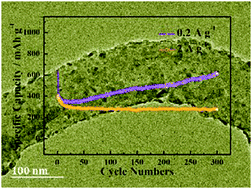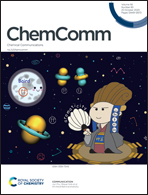Rational design of FeTiO3/C hybrid nanotubes: promising lithium ion anode with enhanced capacity and cycling performance
Abstract
Ilmenite FeTiO3 has the advantage of high theoretical capacity and abundant sources as an anode material for lithium-ion batteries (LIBs). However, it suffers inferior rate capability caused by the aggregation of particles. To solve this problem, FeTiO3 nanoparticles embedded in porous CNTs were developed by the sol–gel route and subsequent calcination. The unique hybrids have a uniform distribution of FeTiO3 nanoparticles (5–20 nm) in the carbon matrix. Electrochemical tests prove that the porous FeTiO3/C hybrid nanotubes deliver a high capacity of 612.5 mA h g−1 at 0.2 A g−1 after 300 cycles. Moreover, they present remarkable rate capability and exceptional cycling stability, possessing 163.8 mA h g−1 at 5 A g−1 for 1000 cycles. The enhanced electrochemical performance of the FeTiO3/C hybrid is derived from the shortened Li+ transport length, good structure stability and conductive carbon matrix, which simultaneously solves the major problems of pulverization and agglomeration of FeTiO3 nanoparticles during cycling.



 Please wait while we load your content...
Please wait while we load your content...